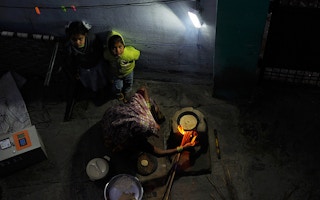Most urban dwellers and residents of developed countries likely take electricity for granted as something they can easily access at the flick of a switch. But this isn’t always the case for people living in remote, rural or impoverished areas, which may not be connected to the electricity grid.
To continue reading, subscribe to Eco‑Business.
There's something for everyone. We offer a range of subscription plans.
- Access our stories and receive our Insights Weekly newsletter with the free EB Member plan.
- Unlock unlimited access to our content and archive with EB Circle.
- Publish your content with EB Premium.
This is where the ability to power homes using solar energy—and without a connection to the main electricity network—can make a difference. Companies realise that there is a market in bringing solar-generated electricity to the 1.1 billion people who lack access today. A key means by which they can do this is to lease solar home systems and allow customers—who often have limited means—to pay for what they can afford, and when they can manage payments.
The recent Global Off-Grid Solar Forum & Expo, held in Hong Kong on 22 and 23 January 2018 and organised by the Netherlands-based Global Off-Grid Lighting Association (GOGLA) and International Finance Corporation (IFC) Global, offered a platform for experts to showcase new products and services that will bring electricity to communities across the world who live off the electricity grid.
Solar energy is clean, sustainable and meets Sustainable Development Goal (SDG) 7 to “ensure access to affordable, reliable, sustainable and modern energy for all”. Burning kerosene or diesel as an alternative causes air pollution and greenhouse gases, and poses health problems through smoke inhalation. So, an off-grid solar business has immense social as well as environmental benefits. Small wonder that companies are flocking to this US$3.9 billion industry.
But as speakers at the conference noted, finding funding for start-up companies can be difficult if investors are not convinced that the proposed product distribution and pay-as-you-go systems will give the right financial returns.
However, the good news according to the 2018 Off-Grid Solar Market Trends Report, is that an estimated 73 million households have benefited from off-grid solar products ranging from small lighting appliances to integrated solar home systems with radios, televisions and home lighting.
A combination of Internet of Things technology and mobile phone payment systems has made it possible for companies to “lease” pay-as-you-go systems to impoverished consumers at modest prices, enabling them to secure a consumer base that is large enough to earn bountiful returns.
Furthermore, such business models can capture rich market data for companies to tailor consumer products; this information is also useful to government agencies for social policy making.
“
Companies realise that there is a market in bringing solar-generated electricity to the 1.1 billion people who lack access today.
Lighting Global, the World Bank Group’s platform to support the off-grid solar market, estimates that only 17 per cent of households with unreliable or no grid access are currently fitted with off-grid energy solutions. Thanks to this low market penetration, there is a large proportion of un-serviced households and customers that solar product suppliers are eyeing with anticipation.
“Access to energy is a powerful enabler for the poor,” stated Gaurav Gupta, Regional Director at New York-based policy and strategy advisory firm Dalberg. But, the trick is to put money back into the wallets of customers through creating livelihoods. “That’s why electricity for sewing machines and pumps [to irrigate crops] is important,” he said.
Off-grid solar can play an even bigger role in developing countries, where feeding hungry mouths is often difficult due to crop failure caused by climate change. Having solar-powered refrigerators in households helps preserve perishable food to alleviate food security concerns.
The need for product standards was identified as a key challenge at the forum. According to GOGLA chief executive officer, Koen Peters, the industry is divided into GOGLA’s “affiliates”, who operate within the recognized industry codes and standards, and the “non-affiliates”, who don’t - and who happen to represent two-thirds of the industry.
This is a problem, because cheaper but unreliable solar products have a higher risk of breaking down and being discarded, causing used batteries to end up as toxic waste. Speakers noted that this dark side of the industry could potentially spoil the market if product standards are not clear and enforceable.
GOGLA is using its influence to bring non-affiliates in line with the industry. Peters admitted that many of the non-affiliates produce high quality products, but are not members of GOGLA. For instance, Chinese companies who have an interest in Africa choose to operate independently due to language and cultural differences.
China will be an important player in the future of off-grid solar, he added.
Sunny outlook
Despite their understandable trepidation regarding the off-grid solar market, investors do view solar companies as prime opportunities which tick all the right boxes for social impact. Even big energy players like Total, General Electric, Electricite de France and Engie are taking a stake in this growing market.
What started off as a corporate social responsibility initiative for many firms has now become a viable business. But as one solar home system supplier pointed out, the off-grid solar volume is still a mere 1 per cent of the total global solar market.
Government attitudes to off-grid solar have changed dramatically over time. Previously regarded as a public function, governments in grid-lacking countries are now passing the responsibility of decentralised energy to private companies. This is condoned by multilateral agencies like the IFC and the United Nations, which offers a CleanStart Program to fund solar companies.
Commenting that “distributed energy is the new economy”, IFC’s Russell Sturm added that developing countries are skipping a generation of technology. In the same way mobile phones skirted the need to install fixed lines, off-grid distributed energy has eschewed costly large-scale grid infrastructure as a way to provide clean and affordable energy access to all.
Ultimately, energy self-sufficient homes will have enough excess electricity to sell down to others in need. As the roll-out of off-grid solar solutions—and microgrids, which hook up houses in the same neighbourhood to one another—this is a bright future that isn’t too far away.









